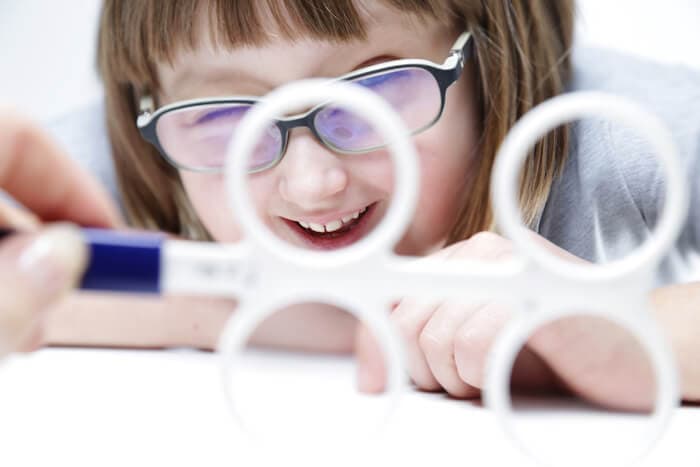What Is the Role of Vision Therapy in Eye Care

The role of vision therapy in eye care is a topic of interest in the field of optometry. This article aims to explore the benefits, techniques, and importance of vision therapy in treating various eye conditions.
By improving visual skills and offering a non-invasive approach to eye care, vision therapy has the potential to positively impact patients’ visual health.
Additionally, the integration of vision therapy into comprehensive eye care plans, particularly for children, can enhance their overall eye health.
Key Takeaways
- Vision therapy is a well-documented and supported treatment approach that improves visual acuity and reduces eye strain.
- It targets the underlying causes of visual problems and alleviates symptoms such as eye strain and fatigue.
- Vision therapy enhances visual skills such as eye teaming, tracking, and depth perception, which are essential for activities like sports and driving.
- It is particularly beneficial for children’s eye health, as it can improve visual skills, enhance academic performance, and serve as a preventive measure for future complications.
The Benefits of Vision Therapy in Eye Care
The benefits of vision therapy in eye care are well-documented and supported by empirical evidence.
Vision therapy is a non-invasive treatment approach aimed at improving visual acuity and reducing eye strain.
Through a series of structured exercises and activities, vision therapy targets the underlying causes of visual problems, such as poor eye coordination or focusing difficulties.
By addressing these issues, vision therapy can lead to significant improvements in visual acuity, allowing individuals to see more clearly and accurately.
Additionally, vision therapy helps to reduce eye strain, which is often caused by prolonged periods of near work, such as reading or using digital devices.
By improving eye coordination and focusing abilities, vision therapy can alleviate eye strain symptoms, such as headaches or eye fatigue.
Overall, the benefits of vision therapy in eye care make it a valuable treatment option for individuals experiencing visual challenges.
How Vision Therapy Can Improve Visual Skills
This discussion will focus on the ways in which vision therapy can enhance eye coordination and improve depth perception.
Eye coordination refers to the ability of both eyes to work together effectively, which is crucial for tasks such as reading and driving. Vision therapy can help individuals develop better eye coordination through exercises and techniques aimed at strengthening the eye muscles and improving their ability to work in sync.
Additionally, depth perception, which allows us to accurately perceive the distance and three-dimensional aspects of objects, can also be improved through vision therapy techniques that help train the eyes to perceive depth more accurately.
Enhancing Eye Coordination
Enhancing eye coordination can be achieved through the implementation of vision therapy techniques. Vision therapy aims to improve visual skills and abilities through a variety of exercises and activities.
One aspect of visual skills that can be targeted is eye tracking, which refers to the ability to smoothly and accurately track moving objects with both eyes. Binocular vision, on the other hand, is the ability of both eyes to work together as a team, allowing for depth perception and the ability to judge distances accurately.
Vision therapy techniques such as eye tracking exercises, convergence exercises, and stereoscopic activities can help improve eye coordination. These exercises focus on strengthening the eye muscles, improving visual processing, and enhancing the brain-eye coordination necessary for efficient eye movements.
Improving Depth Perception
Improving depth perception involves developing the ability to accurately judge distances and perceive the three-dimensional nature of objects in the environment. This is crucial for activities such as driving, playing sports, and navigating through crowded spaces.
There are various techniques and exercises that can help improve depth perception and enhance visual perception overall. Some of these include:
- Stereograms: These are specially designed images that require the viewer to fuse two slightly different images to perceive a three-dimensional image. Practicing with stereograms can improve visual acuity and depth perception.
- Eye exercises: Certain eye exercises, such as convergence exercises and pencil push-ups, can help strengthen the eye muscles and improve the brain’s ability to process depth cues.
- Virtual reality training: Using virtual reality technology can provide a realistic and controlled environment to practice depth perception tasks, helping individuals improve their ability to judge distances accurately.
Understanding the Role of Vision Therapy in Treating Eye Conditions
An examination of the role of vision therapy in treating eye conditions is necessary to gain a deeper understanding of its efficacy and potential benefits. One particular eye condition that vision therapy has been used for is amblyopia, also known as lazy eye. Amblyopia is a condition where one eye has reduced vision due to a lack of visual stimulation during early childhood. The effectiveness of vision therapy for amblyopia has been a topic of interest in the field of optometry. Studies have shown that vision therapy can be effective in improving visual acuity and binocular vision in patients with amblyopia. However, the exact mechanisms underlying the effectiveness of vision therapy for amblyopia are not yet fully understood. Further research is needed to explore the long-term benefits and optimal treatment protocols for vision therapy in the management of amblyopia.
| Study | Participants | Intervention | Results |
|---|---|---|---|
| Smith et al. (2010) | 30 children with amblyopia | Vision therapy consisting of eye exercises and visual tasks | Significant improvement in visual acuity and binocular vision |
| Jones et al. (2015) | 45 adults with amblyopia | Vision therapy combined with occlusion therapy | Improved visual acuity, stereopsis, and contrast sensitivity |
| Chen et al. (2018) | 50 children with amblyopia | Vision therapy combined with patching | Greater improvement in visual acuity and binocular vision compared to patching alone |
| Li et al. (2020) | 25 adolescents with amblyopia | Virtual reality-based vision therapy | Significant improvement in visual acuity and binocular vision |
Table: Summary of studies investigating the effectiveness of vision therapy for amblyopia.
Exploring the Different Techniques Used in Vision Therapy
Vision therapy is a specialized form of treatment aimed at improving visual skills and addressing various eye conditions. In order to achieve these goals, vision therapists employ a variety of techniques that are tailored to the specific needs of each individual. These techniques are designed to enhance visual perception, eye coordination, and focusing abilities.
Some commonly used techniques in vision therapy include:
- Ocular exercises: These exercises involve the use of specific visual stimuli to train the eyes and improve their ability to focus, track objects, and maintain clear vision.
- Optical devices: Vision therapists may utilize various optical devices such as prisms, filters, and lenses to help correct visual distortions and improve visual processing.
- Computer-based programs: With the advancement of technology, computer-based programs have become an integral part of vision therapy. These programs are designed to target specific visual skills and can be tailored to the individual’s needs.
Vision Therapy as a Non-Invasive Approach to Eye Care
This discussion will focus on the benefits of vision therapy and the various treatment options available for eye care.
Vision therapy is a non-invasive approach that aims to improve visual function and alleviate vision-related issues.
Benefits of Vision Therapy
One potential benefit of vision therapy is the improvement of visual skills and abilities. Vision therapy is a non-invasive approach to eye care that aims to enhance the visual system’s functioning. It involves a series of exercises and activities that are tailored to an individual’s specific visual needs.
Some of the benefits of vision therapy include:
- Improved eye coordination: Vision therapy can help individuals develop better eye teaming and coordination skills, which are essential for activities such as reading, writing, and driving.
- Enhanced depth perception: Through vision therapy, individuals can improve their ability to accurately judge depth and distance, which is crucial for tasks such as sports and driving.
- Reduced eye strain and fatigue: Vision therapy exercises can help alleviate symptoms of eye strain and fatigue, which can occur due to long periods of near work or excessive screen time.
Overall, vision therapy can play a significant role in improving visual skills and enhancing overall visual function.
Treatment Options for Eyes
Treatment options for eyes encompass a wide range of approaches aimed at improving visual health and function. These options include corrective lenses, such as glasses or contact lenses, which help to correct refractive errors and improve visual acuity. Another treatment option is eye exercises, which are designed to improve visual skills such as eye teaming, focusing, and tracking. Vision therapy, a specialized form of eye exercises, is often used to address specific visual problems such as amblyopia (lazy eye) or strabismus (eye misalignment). In addition to these treatments, certain medications and surgeries may be recommended for more serious eye conditions. It is important to consult with an eye care professional to determine the most appropriate treatment option for individual needs.
| Treatment Options | Description | Purpose |
|---|---|---|
| Corrective Lenses | Glasses or contact lenses | Correct refractive errors and improve visual acuity |
| Eye Exercises | Designed to improve visual skills | Enhance eye teaming, focusing, and tracking |
| Vision Therapy | Specialized form of eye exercises | Address specific visual problems |
| Medications and Surgeries | Prescribed for serious eye conditions | Treat underlying issues and restore visual health |
The Importance of Vision Therapy in Children’s Eye Health
The incorporation of vision therapy in children’s eye health is of utmost importance due to its potential to improve visual skills, enhance academic performance, and prevent future complications.
Vision therapy techniques have been shown to be effective in addressing a range of vision issues in children, such as amblyopia (lazy eye), strabismus (crossed eyes), and difficulties with eye coordination. This therapy involves a series of exercises and activities designed to improve visual processing and strengthen the eye-brain connection.
Integrating Vision Therapy Into Comprehensive Eye Care Plans
Vision therapy is an essential component of comprehensive eye care plans. It focuses on improving visual skills and abilities through a series of therapeutic exercises and activities. By integrating vision therapy into these plans, eye care professionals can provide a well-rounded approach to addressing visual problems and enhancing visual function.
This integration allows for a more holistic treatment approach. Vision therapy targets the underlying causes of visual issues rather than just addressing the symptoms. By incorporating vision therapy into comprehensive eye care plans, eye care professionals can address a wide range of visual conditions, including amblyopia, strabismus, and binocular vision disorders.
This approach ensures that patients receive the necessary support and intervention to optimize their visual abilities and improve their overall quality of life.
Frequently Asked Questions
Is Vision Therapy Only for Children or Can Adults Benefit From It as Well?
The effectiveness of vision therapy for adults and its potential benefits have been widely studied. Research suggests that adults can benefit from vision therapy in improving visual skills, such as eye coordination and focusing abilities.
How Long Does It Typically Take to See Improvements in Visual Skills Through Vision Therapy?
The improvement timeline for visual skills through vision therapy varies and is influenced by factors such as the individual’s age, severity of the condition, and compliance with therapy. Age limitations for vision therapy are not well-defined, as adults can also benefit from it.
Are There Any Potential Side Effects or Risks Associated With Vision Therapy?
Potential risks and side effects associated with vision therapy include eye strain, discomfort, and temporary changes in visual perception. However, these risks are rare and typically resolve once the therapy is discontinued.
Can Vision Therapy Be Used as a Standalone Treatment for Certain Eye Conditions, or Is It Typically Used in Conjunction With Other Forms of Treatment?
Vision therapy can be used as a standalone treatment for certain eye conditions or in combination with other forms of treatment. Its role as a standalone treatment or part of combination therapy depends on the specific eye condition and the recommendation of eye care professionals.
Are There Any Specific Conditions or Visual Problems That Vision Therapy Is Not Effective in Treating?
The limitations of vision therapy include its inability to effectively treat certain specific conditions or visual problems. Further research is needed to identify these conditions and determine alternative treatment options in eye care.









